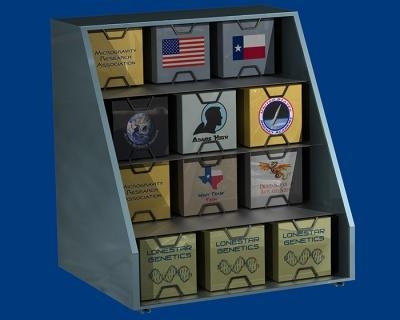Lynx Cub Payload Carrier Developed At Texas A&M
The first Lynx Cub Payload Carrier, a new research platform which promises to dramatically reduce the cost of access to space for small scientific and education payloads has been delivered to the United States Rocket Academy. The Lynx Cub Carrier will fly on the XCOR Lynx spacecraft, which is now under construction at the Mojave Air and Space Port.

"The Lynx Cub Payload Carrier is a versatile system that installs in the Lynx cabin, behind the pilot's seat, allowing small experiments to be carried as secondary payloads on any Lynx flight," said United States Rocket Academy chairman Edward Wright. "The Cub Carrier can be installed and removed quickly for frequent, low-cost flight opportunities.
"The Lynx Cub Carrier is an ideal platform for small materials-processing, fluid-physics, life-science, and engineering experiments. University teaching and research, K-12 education, citizen science, government and industrial R&D will all benefit from the convenient simple interfaces, rapid integration, and affordability of Lynx Cub experiments."
The Lynx Cub Carrier was developed by the United States Rocket Academy and the Space Engineering Research Center, part of the Texas A&M Engineering Experiment Station (TEES), with support from XCOR Aerospace. Design and fabrication of the Lynx Cub Carrier were performed by Texas A&M faculty and students and TEES researchers.
Citizens in Space, a project of the United States Rocket Academy, will use the Lynx Cub Carrier on 10 Lynx missions. The Lynx Cub Carrier will also be made available to other XCOR customers, as ready-to-fly hardware or as an open-source hardware design.
"Lynx Cub payloads are based on the popular 1U, 2U, and 3U CubeSat form factors, which are de facto international standards for small scientific payloads," said Chip Hill, Director of the Space Engineering Research Center. "The payload carrier provides physical accommodations, electrical power, and limited thermal control for Lynx Cub experiments."
The Lynx Cub Carrier will be part of the XCOR Lynx flight-test program, which is expected to begin later this year. "For the test flights, we will load the Lynx Cub Carrier with payload simulators, accelerometers, gyroscopes, and environmental sensors," Wright said. "While XCOR is proving out the vehicle, we'll be gathering baseline data on the thermal environment, acoustical environment, acceleration, vibration, and other parameters -- data that will help guide experimenters in their payload design."
"I am excited by the connection to K-12 education," said Dr. Justin Yates, a professor at the Texas A&M Department of Systems and Industrial Engineering who served as a project lead. "I am proud that Texas A&M industrial engineers could play a part in this project, which will excite, engage, and educate the next generation of scientists."
"The Lynx Cub Carrier development was a great learning experience," said Austin Goswick, a senior Systems and Industrial Engineering student who worked on the project. "This project tested me in every way, advancing my communication skills as well as my engineering skills. I can't wait to hear how it performs in the flight test."
The Space Engineering Research Center, part of the Texas A&M Engineering Experiment Station (TEES) in College Station, is also a member of XCOR's global network of payload integrators, which provides value-added services for Lynx payload customers. TEES is an engineering research agency of the State of Texas and a member of The Texas A&M University System.
(Image from file)
 ANN's Daily Aero-Term (05.01.24): Say Altitude
ANN's Daily Aero-Term (05.01.24): Say Altitude ANN's Daily Aero-Linx (05.01.24)
ANN's Daily Aero-Linx (05.01.24) Classic Aero-TV: Korean War Hero Twice Reborn
Classic Aero-TV: Korean War Hero Twice Reborn Airborne 04.29.24: EAA B-25 Rides, Textron 2024, G700 Deliveries
Airborne 04.29.24: EAA B-25 Rides, Textron 2024, G700 Deliveries Airborne Affordable Flyers 05.02.24: Bobby Bailey, SPRG Report Cards, Skydive!
Airborne Affordable Flyers 05.02.24: Bobby Bailey, SPRG Report Cards, Skydive!



